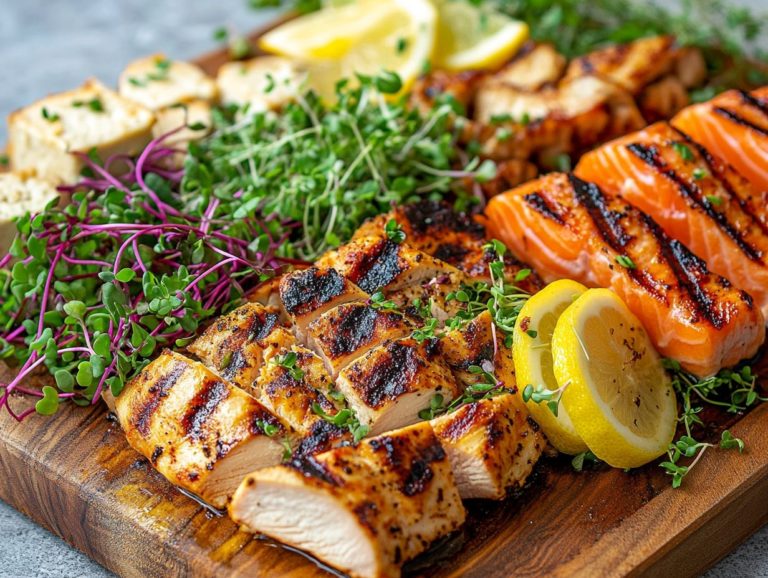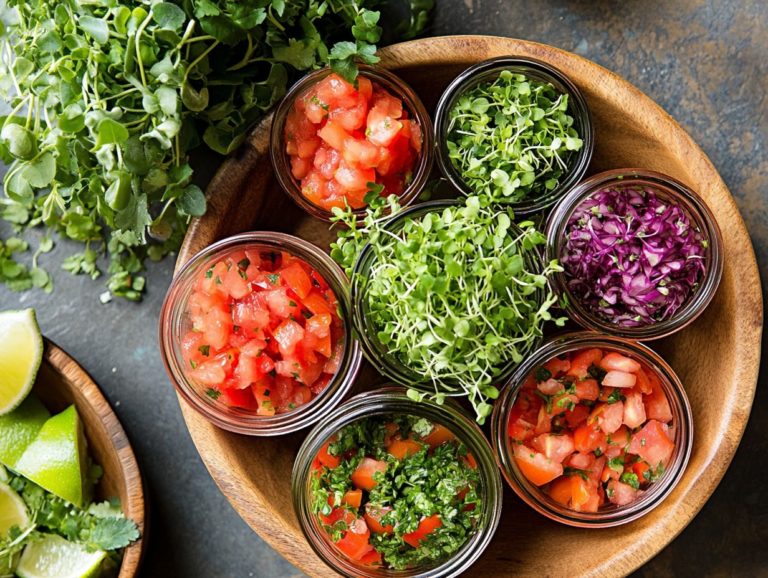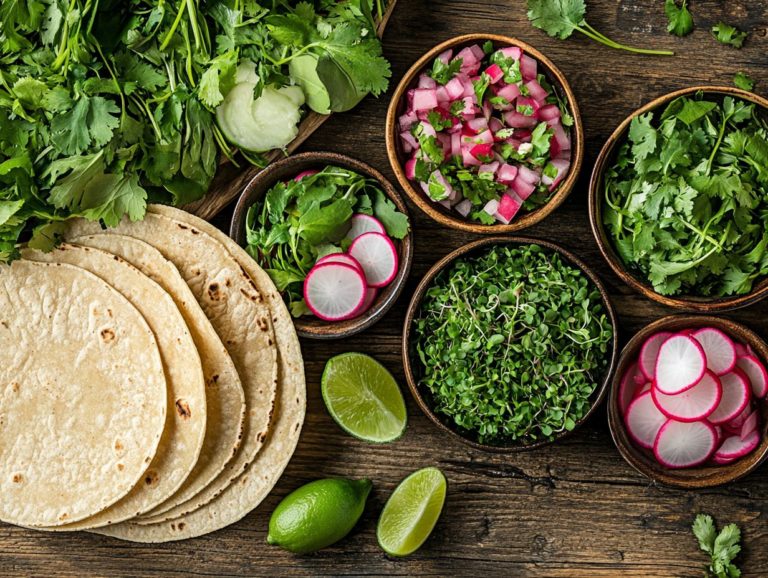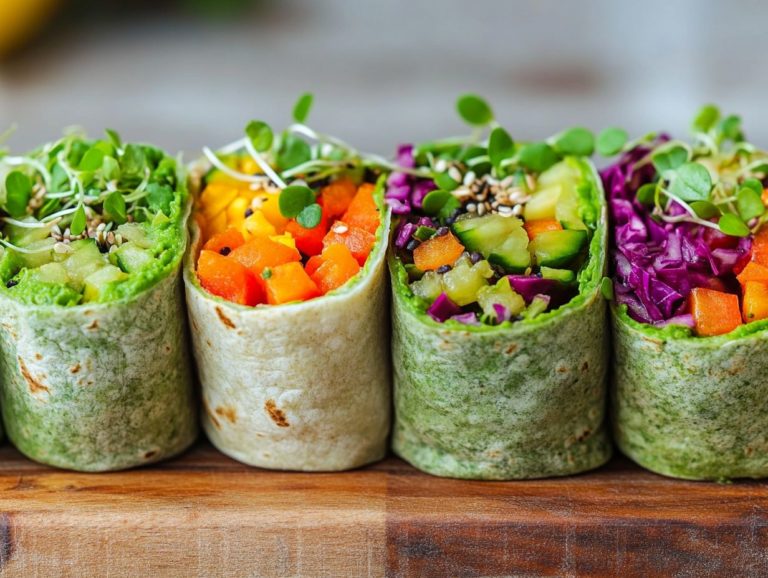45. Microgreens in Regional Cuisines: A Look
Microgreens are not just tiny plants; they’re little powerhouses of flavor and nutrition, ready to enhance your culinary creations. Get ready to discover the amazing world of microgreens!
As culinary trends increasingly favor fresh and vibrant ingredients, these miniature greens have secured their spot in regional cuisines across the globe. This article explores the nutritional value, various types, and traditional uses of microgreens, along with a step-by-step guide on how to grow and prepare them.
Uncover a treasure trove of recipes and tips that will elevate your everyday meals with these versatile greens. Dive in and start transforming your cooking now!
Contents
Key Takeaways:

- Microgreens, tiny greens that pack a punch of flavor and nutrition, are gaining popularity in local cuisines around the world.
- These greens boost nutrition and make meals look great, offering numerous benefits to regional cuisine.
- With a variety of types and easy growing and preparation methods, anyone can incorporate microgreens into their everyday meals with creative and delicious results.
What are Microgreens?
Microgreens are young, edible plants harvested shortly after germination. They are perfect for adding a splash of color and a burst of flavor to your dishes. Whether it s micro basil, arugula, or radish greens, these tiny greens aren t just a feast for the eyes; they pack a punch in terms of health benefits.
Both chefs and home cooks are increasingly appreciating the role of microgreens in modernist cuisine, where the marriage of aesthetics and nutrition is truly celebrated. For some innovative ideas, check out creative uses of microgreens in fusion cuisine. To cultivate them, simply sow seeds in a shallow layer of soil and nurture them in a controlled environment until they are ready for harvest. This method guarantees freshness and amplifies their impressive nutrient profile, including vitamins A, C, E, and K, along with essential antioxidants.
In the culinary world, microgreens have secured their spot on plates, enhancing everything from salads to sandwiches with their intense flavors and delightful crunch. In Bengaluru, local chefs like Vikas Seth have recognized this trend and are creatively incorporating these greens into casual dining menus, elevating dishes and transforming healthy eating into an exciting cooking adventure. For those interested in exploring more, check out cooking with microgreens for flavor and nutrition inspiration.
Benefits of Incorporating Microgreens in Regional Cuisines
Incorporating microgreens into your regional cuisine brings a wealth of advantages. They enrich your dishes with vibrant flavors and notable health benefits that help combat chronic diseases.
These tiny greens boost nutrition and make meals look great, enhancing meals crafted by local chefs, including those at esteemed venues like Embassy Leisure in Bengaluru. Their contribution to promoting clean eating resonates with contemporary trends in environmental activism, positioning them as essential elements in today’s culinary landscape, especially in dishes highlighted in the microgreens in Italian cuisine: recipe guide.
Nutritional Value and Flavor Enhancement
Microgreens are truly a culinary treasure, renowned for their exceptional nutritional value. They pack a concentrated punch of vitamins, minerals, and antioxidants that can significantly enhance your overall health while also elevating the flavor profile of your dishes.
With their vibrant colors and intriguing textures, microgreens do more than just nourish; they add a visually striking element to your meals, making them an essential component in the art of food plating. To learn more about incorporating these greens into your dishes, check out how to use microgreens in traditional dishes. Chefs like Vikas Seth and Nimish Bhatia appreciate their role in crafting stunning presentations.
These petite greens think broccoli, radish, and arugula are loaded with nutrients like vitamin C, vitamin K, and essential amino acids. The peppery bite of radish microgreens can elevate a simple salad into a gourmet experience, while the delicate crunch of pea shoots offers a refreshing contrast to rich sauces.
In Bengaluru’s modernist dining scene, chefs artfully incorporate these greens to create beautiful dishes, layering them alongside foams and emulsions that enhance both the dish s visual appeal and the tastes of discerning diners.
Types of Microgreens Used in Different Regional Cuisines
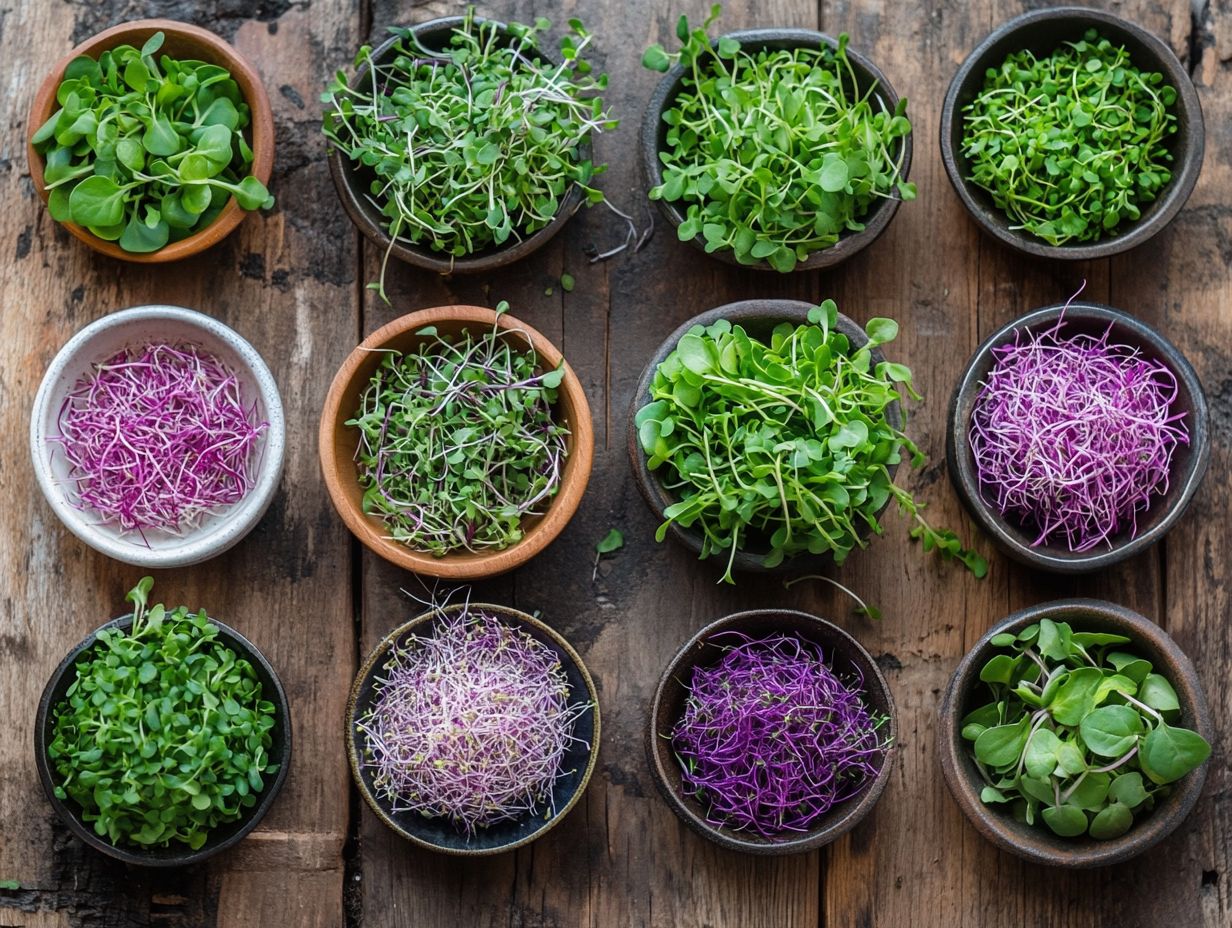
Various types of microgreens are embraced in regional cuisines. Each contributes distinct flavors and nutritional advantages to your culinary endeavors. Imagine the spicy zest of radish microgreens or the subtle sweetness of pea shoots, enhancing a medley of dishes.
Local chefs are buzzing about these young greens! Take Bengaluru, for instance; places like Embassy Leisure craft innovative dishes that beautifully highlight these vibrant greens, showcasing their versatility and flair.
Examples and Traditional Uses
Microgreens often take center stage in traditional recipes. They act as both a garnish and an essential component that elevates flavor and aesthetics.
Each variety, from sunflower to mustard greens, contributes its distinct taste. This makes them a favorite among chefs striving to innovate while honoring traditional flavors.
In the realm of casual dining in Bengaluru, the inclusion of microgreens speaks volumes about the rising trend toward clean eating and visually stunning presentations.
Local culinary experts highlight the significance of microgreens in beloved dishes like the classic masala dosa. Those vibrant green leaves introduce an unexpected crunch and freshness.
In salads, these delicate sprouts add a layer of flavor that beautifully complements local ingredients. Chefs are reimagining traditional recipes, embracing microgreens not just for their nutritional perks but also for their striking colors.
This transforms ordinary meals into memorable gastronomic experiences. As restaurants increasingly prioritize aesthetics, the use of microgreens is essential. Every plate delivers a feast for both the eyes and the palate.
How to Grow and Prepare Microgreens for Cooking
Growing and nurturing microgreens for your culinary creations is immensely rewarding. You ll savor fresh, vibrant greens right from your kitchen!
By using techniques like Aquaponics a method of growing plants in water enriched with nutrients from fish you can elevate your growing experience while supporting sustainable eating practices.
With their minimal space requirements, microgreens seamlessly integrate into urban lifestyles. This makes them a perfect choice for anyone committed to clean eating.
Step-by-Step Guide
Get ready to dive into the rewarding journey of growing microgreens! Start from selecting the perfect seeds to harvesting those vibrant greens that will elevate your culinary creations.
Begin with clean, nutrient-dense soil and high-quality seeds. You ll cultivate a variety of microgreens tailored to your taste preferences and nutritional needs, all while embracing a sustainable approach to eating.
Understanding the different types of microgreens, such as basil, radish, and sunflower, enables you to choose those that not only cater to your palate but also enhance the nutritional profile of your meals.
Gather essential supplies like seed trays, a gentle spray bottle for watering, and adequate light sources. This will set you on the right path to success.
Timing is vital; most microgreens are ready for harvest within 7 to 21 days, depending on the variety you choose. As they grow, maintaining proper moisture levels and airflow will help them flourish.
Enjoy the fresh flavors and vibrant colors they contribute to salads, sandwiches, and smoothies.
Integrating these nutrient-packed greens into your clean eating regimen enhances your health with vital vitamins and antioxidants. It also elevates your culinary experience by adding depth of flavor and texture to your dishes.
Innovative Recipes Featuring Microgreens

Innovative recipes featuring microgreens are constantly emerging. They showcase the culinary creativity of local chefs who truly recognize the value of these nutrient-dense greens in contemporary cuisine.
From vibrant salads to gourmet dishes, these recipes highlight the unique flavors of microgreens. They offer you an interactive dining experience that engages all the senses, seamlessly aligning with the clean eating movement. For more inspiration, consider exploring microgreen varieties in different cuisines.
Creative Ways to Use Microgreens in Dishes
Explore exciting and tasty ways to use microgreens! Whether it s garnishing a gourmet plate or blending them into sauces and dressings, these greens elevate flavors to new heights. Their unique textures are perfect for modern plating techniques, making them favorites among chefs who aim to impress with visually stunning and flavorful creations.
Imagine a salad bursting with color and flavor! Simply top it with an array of colorful microgreens for a feast for the eyes and a delightful burst of fresh flavor. You can even blend them into dips, like a creamy avocado spread, where their subtle yet distinct taste enhances the overall experience. For some delicious ideas, check out the best microgreens recipes to try!
As food trends prioritize aesthetics and health, use microgreens to boost nutrients without sacrificing style. This delicate addition captivates the eye and appeals to health-conscious diners seeking nourishment alongside an artful presentation. Explore the evolution of microgreen varieties in cuisine to learn more about their culinary impact.
Tips for Incorporating Microgreens in Everyday Meals
Incorporating microgreens into your everyday meals is effortless and gratifying, providing an explosion of flavor and nutrition that doesn’t demand hours in the kitchen.
These vibrant greens can elevate ordinary dishes into great meals, making them essential for anyone dedicated to clean eating and health-conscious diets.
Simple and Delicious Ideas
You ll discover simple and delicious ways to incorporate microgreens into your cooking. Whether you re adding them to a sandwich, tossing them into a salad, or using them to enhance a grilled chicken dish, their versatility allows for delightful creative expression in casual dining.
Imagine blending them into vibrant smoothies for an invigorating nutrient boost or sprinkling them atop homemade pizzas; the possibilities are endless. Microgreens can enhance the flavor of your omelets, bringing a fresh twist to your morning routine, or be folded into grain bowls for that perfect pop of color and taste. To discover more about these unique ingredients, check out exploring the culinary world of microgreen varieties.
If you want to impress, consider a simple microgreen pesto. It s an elegant, nutrient-rich condiment that elevates any dish. By weaving these tiny greens into your meals, you cultivate a sense of culinary creativity while promoting a balanced diet rich in essential vitamins and minerals.
Frequently Asked Questions
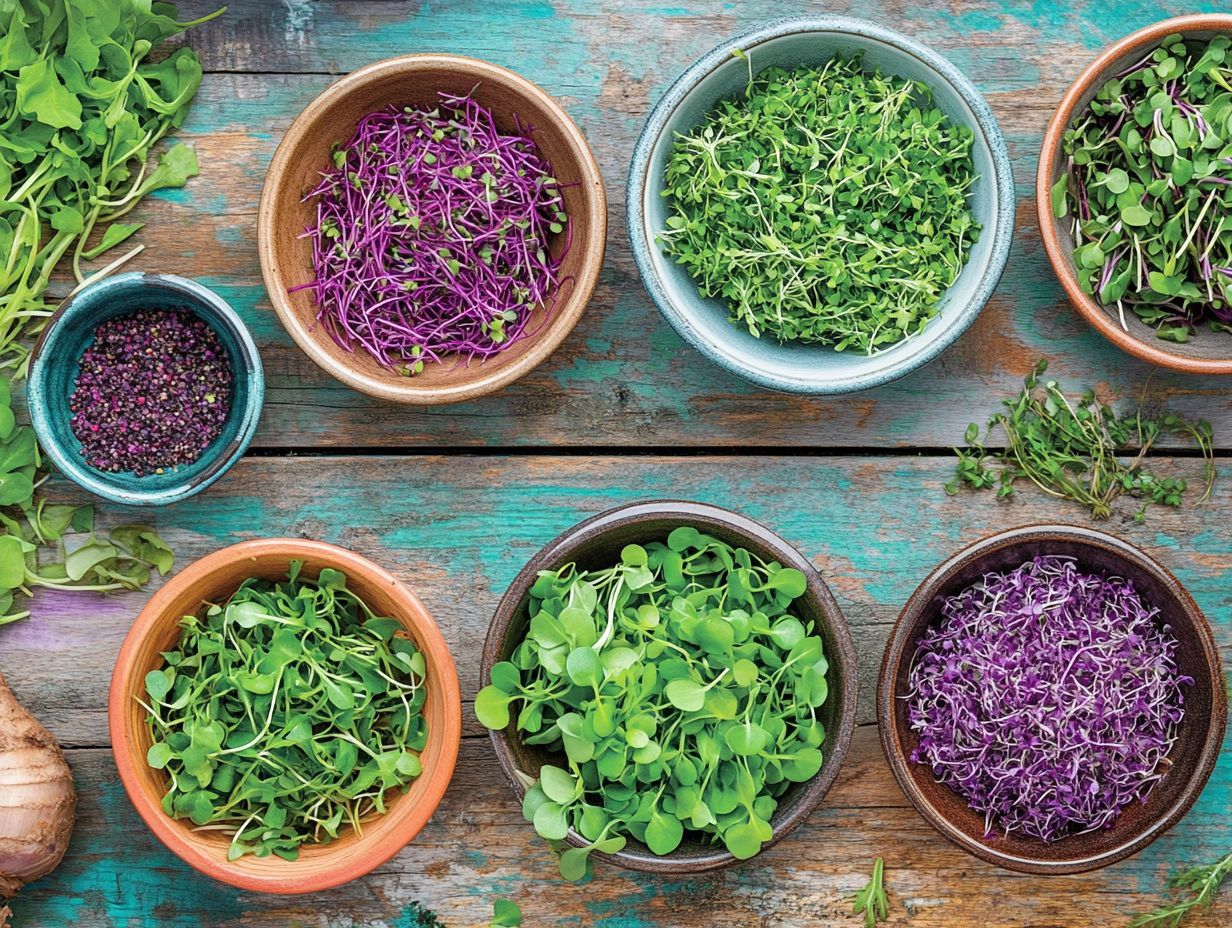
What are microgreens?
Microgreens are young, edible plants harvested after the first few leaves develop. They are smaller than baby greens but larger than sprouts and are packed with nutrients, flavor, and texture.
What role do microgreens play in regional cuisines?
Microgreens add a burst of flavor, texture, and color to dishes in many regional cuisines. They are especially popular in Asian, Middle Eastern, and Mediterranean cuisines.
How are microgreens grown?
Microgreens can be grown indoors or outdoors and require minimal space and equipment. Typically, they are grown in trays or containers with a growing medium and are ready to harvest within 1-3 weeks.
What are the health benefits of microgreens?
Microgreens are packed with nutrients such as vitamins, minerals, antioxidants, and enzymes. Low in calories and high in fiber, they make a healthy addition to any diet.
What are some popular microgreens used in regional cuisines?
Popular microgreens include garlic chives in Chinese cuisine, fenugreek in Indian cuisine, and watercress in French cuisine. They are also commonly used in salads, sandwiches, and as garnishes.
Can microgreens be grown at home?
Yes! Microgreens can easily be grown at home with minimal space and equipment. They can be grown in containers or trays and only require regular watering and sunlight. Why not start your own microgreen garden today? It’s easy and rewarding!

